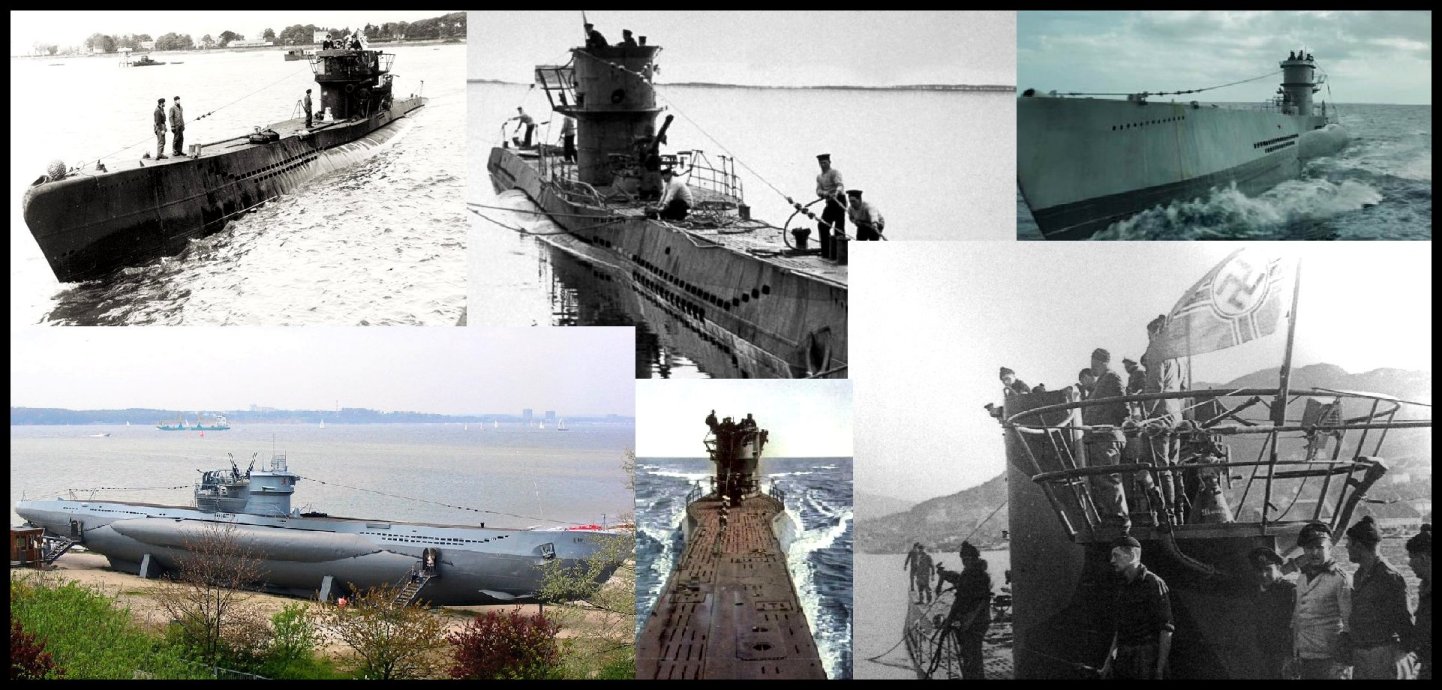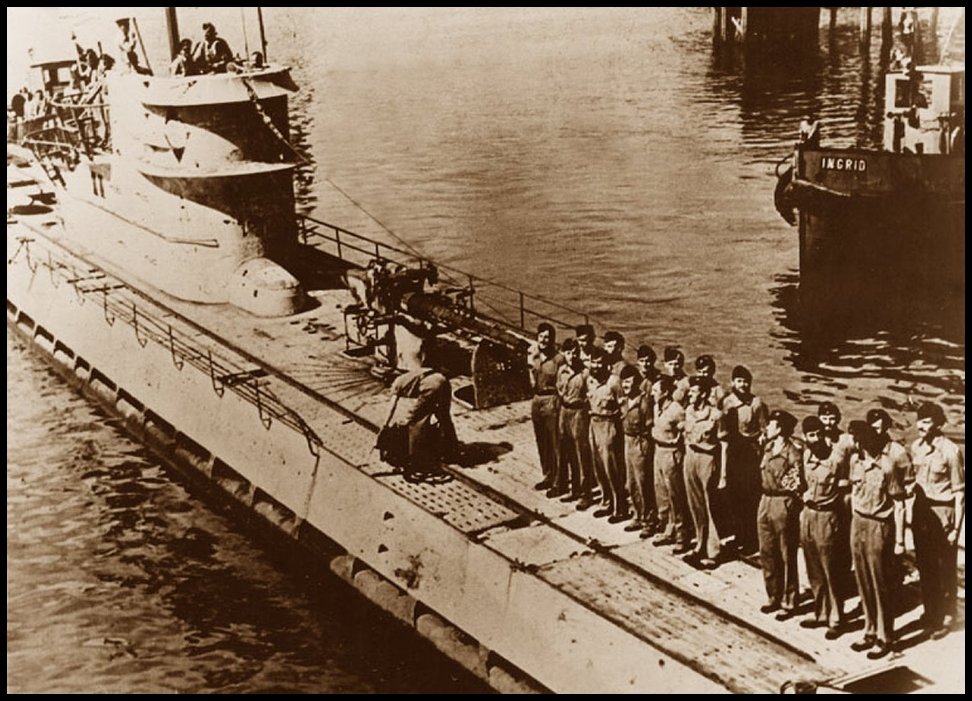


Robert-Richard Zapp commanded U-66 (Type IXC U-Boat)
Sinking Five Ships = 33,456 Tons during 'Operation Drum Beat'
Study of the German U-boat is one of the most fascinating subjects of WWII. Many of us are drawn to the
unbelievable successes during the outbreak of the war. And to this day the most accurate portrayal
of these menacing underwater threats remains Wolfgang Petersen's Das Boot. In this realistic portrayal
we see extremely cramped conditions that U-boat crews suffered. The story line covers more or less the
end of the 'Happy Days' as technology and available resources finally caught up with the
hunters as they became the hunted.
================================================================================================
"The Happy Time"
The battle of the Atlantic was initially very successful for Karl Dönitz who created a strategy called
'Rudeltaktik' or "tactics of a pack" of animals. The common terminology we know as 'Wolfpack'.
Despite initial German successes, the Americans and British created methods to turn the tide. Wolfpacks
required detailed radio communication to coordinate their attacks. This resulted in the U-boats
becoming vulnerable to High Frequency Direction Finders, known as "Huff-Duff" which allowed the
USN and her allies to pinpoint their locations who were transmitting and thus attack them.
In addition, effective air cover, including long-range planes equipped with radar, along with
escort carriers and blimps were employed. These effective approaches revealed the locations
of U-boats as they were shadowed until the time was right to strike! In the end, this elite force
of Kriegsmarine suffered casualties deemed the worst during the entire war!
Among 39,000 German sailors 70% never returned.
================================================================================================
'Operation Drumbeat'
Its still amazing that so few Americans realized how close the Kriegsmarine came to America's
East Coast during what German U-boat crews referred to as the 'The Second Happy Time.'
During 'Operation Drumbeat.' Dönitz's U-boats attacked with impunity sinking 300-400 ships
at a loss of approx. 5,000 lives, (an estimated 200,000 tons) of allied shipping. German submarine
commanders referred to this as the "American Shooting Season." Surprisingly only five
type IX U-boats were deployed in the initial phase of 'Operation Drumbeat' attacks.
Growing up in New Jersey and with a love for the ocean, I took up Scuba Diving in the North Atlantic
in the 1970's. The group I joined chartered dives off the coast of central N.J. catching lobsters,
crabs and picking up souvenirs.

It was during this period I learned about the popularity of U-352 sunk off
North Carolina by Coast Guard Cutter Icarus. The wreck of U-352 is very accessible lying at a depth
of 115 feet, (no decompression necessary), with 15 minutes bottom time. The story of the Icarus
remains one of the most dramatic events exposing 'Operation Drumbeat.' Pursuing the U-boat, commanding officer,
Lt. Maurice Jester intended on ramming her (a popular approach). The relatively small but fast craft used a
combination of depth charges, her 3" gun and constant machine gunning as the U-boat surfaced before finally sinking.
As the Gov't and the United States Navy continued to ignore the seriousness of coastal attacks, they
used propaganda and secrecy to avoid panic and save face. According to interviews,
with one of the most skilled U-boats captains, Reinhard Hardegen U-123:
“We listened to the American radio transmissions and we heard,
‘We have sunk a U-boat.’ We were supposed to have been sunk three times. Every time we
sank a ship, we were sunk again. The Americans obviously needed this as a
consolation—the idea that they had done something. But it wasn’t true.”
Captain Hardegen continued his amazing successes stirring the hearts of elite U-boat crews,
sinking two ships off Long Island. He drew close enough to New York City cleary recognizing
the glow from Manhattan’s skyscrapers during the night!
“It was a very easy navigation for me,” he told Stephen Ames, a filmmaker,
remembering how his approach was assisted by lights
along the shoreline. As he neared the entrance to New York’s Lower Bay
the night of Jan. 14, 1942, Captain Hardegen climbed the bridge
of U-123 and witnessed an illumination that absolutely excited him!
Many historians refer to Drumbeat as a 'Bonanza' for the U-boats during this astounding brief, bold success.
The five Type IX boats in the first wave of attack cruised the coastline safely submerged during the day.
Surfacing at night they torpedoed mostly merchant vessels silhouetted against city lights. If there was
a responsible party, blame falls upon USN Admiral King, (preoccupied with Japanese battles in the Pacific).
King already had a strained relationship with Britain and it was his decision to focus limited escort protection
defending troop transports across the Atlantic effectively. Finally when enough escort destroyers and
other vessels became available, a defensive parameter of convoys was established which reduced
U-boat attacks and sinkings to practically nothing.
During combined operations of 'Drumbeat' and 'Neuland' (the Carribean), U-boats sank
609 ships totaling 3.1 million tons and the loss of thousands of lives compared to a loss of only 22 U-boats!
Although less than losses during the First World War it was roughly one quarter of all shipping sunk
by U-boats during the entire Second World War!
Drumbeat Tally
Reinhard Hardegen in U-123 sank seven ships totalling 46,744 tons
before he ran out of torpedoes and returned to base.
Ernst Kals in U-130 sank six ships of 36,988 tons.
Robert-Richard Zapp in U-66 sank five ships of 33,456 tons.
Heinrich Bleichrodt in U-109 sank four ships of 27,651 tons, and
Ulrich Folkers on his first patrol in U-125 sank one ship 6,666 tons
More About Operation Paukenschlag Commanders
================================================================================================
'Recently Discovered U-boats - Solved and Unsolved Mysteries'
Fifty years ago 'Sport Diving' was considered a novelty. Few divers recognized the seriousness of
underwater grave sites and went about extracting whatever they found. As the years went by, N.J. wreck
and sport divers became more respectful of under water wrecks containing human remains. During my
diving career I met experienced diver and author Gary Gentile who lectured in the tri-state area.
He dove with some of the same people and boat crews I was associated with.
Enter the scene: Contemporary professional divers John Chatterton and Richie Kohler who also began their respective
diving careers off the coast of New Jersey. In 1991 Chatterton and Kohler (along with fellow diver Bill Nagle)
made an astounding discovery. At a hazardous depth of 240 feet they discovered the remains of a U-boat
that wasn't supposed to be there. In what was to become one of the most thrilling stories, sadly three
divers lost their lives, (breathing deep dive gas mixtures) as they tried to solve the mystery. Documenting
the six year search, a book publication and a documentary revealed the intense story which led Chatterton and
Kohler on multiple trips to Germany to visit U-boat veteran and archivist Horst Bredow of the Deutsches
U-Boot-Museum in Altenbruch. Much to Horst Bredow's surprise the discovery of personal effects from
Kriegsmarine crew member Martin Horenburg, in addition to an actual equipment box tag, led the team
to a long held mistaken locality of wreck U-869. It was actually thousands of miles from where the Deutsches
Archives indicated it was supposed to have sunk, off Rabat North Africa!
What continues this most amazing mystery is the fact that Chatterton and Kohler's answer to what caused the
U-boat sinking has been debated by several sources including diver Gary Gentile.
================================================================================================

Sources:
The Nat'l Archives - U Boat.Net - WWII Today - You Tube - Eric Wiberg
www.u-boote.fr - LiveAuctioneers - Gönczy Zoli honlapja - Bundesarchiv
Das Boot - Pinterest - Wikipedia - Gary Gentile - Warfare History Network
Deutsches U-Boot-Museum - John Chatterton and Richie Kohler
Olympus Diving - USCG - Robert Kurson - Naval History and Heritage Command
New Jersey Scuba Diving
2019 © ww.ww2survivorstories.com